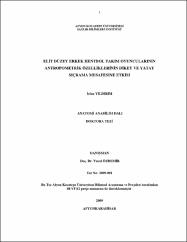Elit Düzey Erkek Hentbol Takım Oyuncularının Antropometrik Özelliklerinin Dikey ve Yatay Sıçrama Mesafesine Etkisi
Özet
Bu çalışmanın amacı, elit düzey erkek hentbol takım oyuncularının
antropometrik özelliklerinin, dikey ve yatay sıçrama mesafesine etkisinin
incelenmesidir.
Bu araştırma için; Türkiye süper lig erkek hentbol takım oyuncularından 56
sporcuya ölçümler uygulandı. Ayrıca 56 spor yapmamış bireyden oluşan kontrol
grubuna da aynı ölçümler uygulanarak toplam 112 kisi üzerinde araştırma yapıldı.
Araştırmada deneklerin antropometrik ölçümleri, bacak kuvveti, esneklik testi
(otur-eris), dikey ve yatay sıçrama mesafeleri ölçüldü.
Bu çalışmada istatistiksel sonuçların elde edilmesinde SPSS 16.0 paket
programı kullanıldı. Deneklerin antropometrik profillerinin belirlenmesi için T testi,
sporcuların millilik düzeylerini belirlemek için yüzde ve frekansları ile sporcuların
antropometrik ölçümlerinin yatay ve dikey sıçrama mesafesine etkisini belirlemek
için Varyans Analizi Testi uygulandı. Varyans analizi için SPSS programından GLM
(Genel Dogrusal Model) Opsiyonu ve Duncan Çoklu Karşılaştırma testleri
uygulandı. Anlamlılık düzeyi 0.01 ile 0.05 olarak belirlendi.
Araştırmaya katılan elit hentbolcuların; yaş ortalamaları 24.91, boy uzunluğu
ortalamaları 188,7 cm, vücut ağırlığı ortalamaları 89,9 kg, dikey sıçrama mesafeleri
52,3 cm ve yatay sıçrama mesafeleri 238,1 cm orak belirlendi.
Elit hentbolcuların ölçümlerinden; boy uzunluğu, vücut yağ yüzdesi, göğüs
çevresi, bel çevresi, uyluk çevresi, baldır çevresi, biiliak çapı, el bileği çapı, uyluk
uzunluğu, baldır uzunluğu, bacak kuvveti ve esnekliklerinin dikey sıçrama mesafesine istatistikî olarak önemli derecede etken oldukları tespit edildi (p<0,01).
Yine hentbolcuların yas, vücut ağırlığı, omuz çevresi, ön kol çevresi, el bileği
çevresi, femur bikondüler çapı, göğüs derinliği çapı ve tüm kol uzunluklarının dikey
sıçrama mesafesinde istatistikî olarak etkili oldukları görüldü (p<0,05).
Elit hentbolcuların yatay sıçrama mesafelerine ön kol çevresi ve baldır
uzunluğu (p<0,01) ile boy uzunluğu, vücut yağ yüzdesi, bel çevresi, biakromial çapı,
biiliak çapı, el bileği çapı, göğüs derinliği çapı ve esnekliklerinin (p<0,05) etkili
oldukları tespit edildi.
Yaş arttıkça dikey sıçrama mesafesinin de paralel olarak arttığı görüldü. Ön
kol çevresi arttıkça dikey ve yatay sıçrama mesafelerinin de arttığı tespit edildi.
Baldır çevresi arttıkça dikey ve yatay sıçrama mesafelerinin de arttığı görüldü.
Vücut ağırlığı arttıkça dikey ve yatay sıçrama mesafelerinin düştüğü görüldü.
Vücut yağ yüzdesi arttıkça dikey ve yatay sıçrama mesafelerinin azaldığı gözlendi.
Uyluk çevresi arttıkça dikey sıçrama mesafesinin azaldığı görüldü.
Sonuç olarak Elit Düzey Erkek Hentbol Takım Oyuncularının antropometrik
özelliklerinin, dikey ve yatay sıçrama mesafelerine önemli etkileri olduğu tespit
edildi. The aim this dissertation is to study the effects of anthropometric features of
elite male handball team players on the vertical and horizontal jump distance.
For this study, the measures were applied to 112 people, 56 of whom being
players in the Turkish Super League teams and 56 of whom being the control group
who have not played sports.
For the research, the anthropometric measures, leg force, flexibility tests (sitreach)
and vertical and horizontal jump distance of the subjects were measured.
In order to get the statistical results SPSS 16.0 program was used. T test to
determine the anthropometric profiles of the subjects, Variance Analysis Test to
determine the national level of the subjects and to determine the percentage and
frequency and the effects of anthropometric measurements to horizontal and vertical
jump distance were used. For the variance analysis GLM (General Linear model) and
Duncan multiple comparison tests were used. Meaningfulness level was found 0.01
and 0.05.
The average age of height of the elite handballers in the research was 24,91,
average height was 188,7 cm, average weight was 89,9 kg, vertical jump distance
was 52,3 cm and horizontal jump distance was 238,1 cm.
As an outcome of measurements, it has been concluded that height, under
skin fat thickness, chest size, waist size, thigh size, shin size, leg force and the
flexibility of the leg are statistically very active in the vertical jump distance (p<0,01)
Similarly, and age, weight, shoulder size, front arm size, wrist size, femur bicondular size, chest depth size and all arm length are statistically important in vertical jump
distance.
Front arm size and thigh size (p<0,01) and height, the fat percentage of the
body, waist size, biacromial size, biilak size, wrist size, chest size and flexibilities
(p<0,05) are important.
It has been found out that as age increases, vertical jump distance, in a
parallel way, increases. As front arm size increases, the vertical and horizontal jump
distances, also, increase. As thigh size increases, the vertical and horizontal jump
distances increase.
It has been found out that as weight increases, in a parallel way, the vertical
and horizontal jump distances decrease. As the percentage of body fat increases
vertical and horizontal jump distances decrease. As shin size increases, the vertical
jump distance decreases.
Consequently, it has been concluded that the anthropometric features of Elite
Team Handballers have important effects on vertical and horizontal jump distances.
Bağlantı
http://hdl.handle.net/11630/4002Koleksiyonlar
- Doktora Tezleri [156]



















